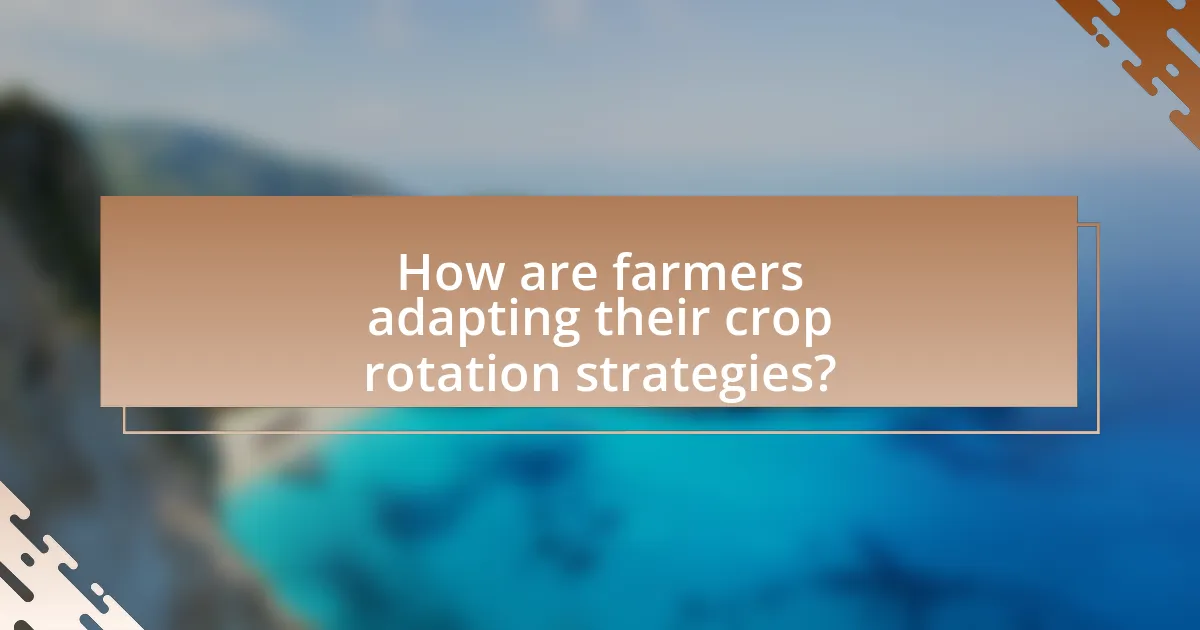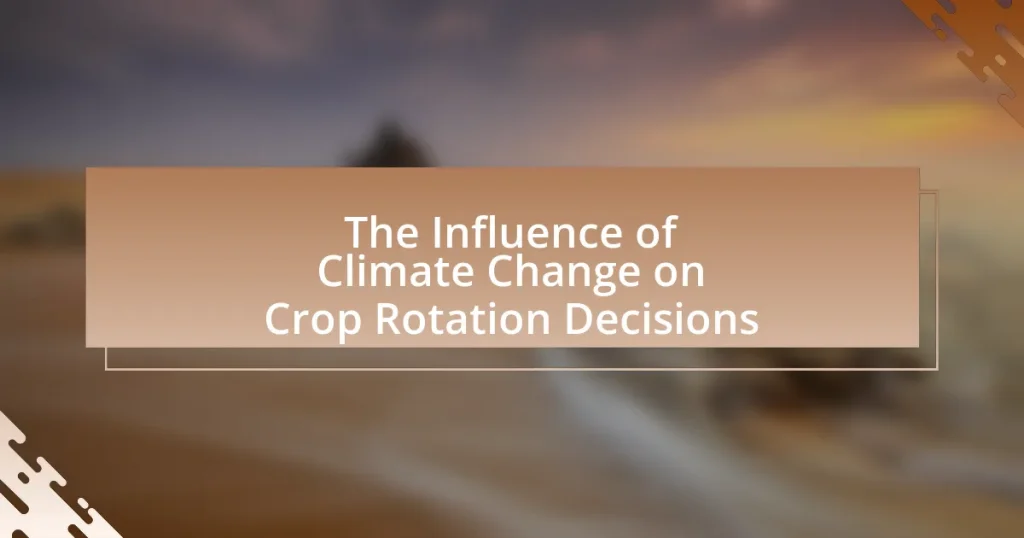The article examines the significant influence of climate change on crop rotation decisions, highlighting how alterations in temperature and precipitation patterns affect agricultural practices. It discusses the adaptive strategies farmers are employing, such as shifting to heat-tolerant crops and adjusting planting schedules to mitigate risks associated with climate variability. Key factors influencing crop rotation include temperature, soil moisture, and changing rainfall patterns, which directly impact crop yields and soil health. The article also explores the economic implications of these changes, the challenges farmers face, and innovative practices being adopted to enhance sustainability and productivity in agriculture.

What is the Influence of Climate Change on Crop Rotation Decisions?
Climate change significantly influences crop rotation decisions by altering temperature and precipitation patterns, which affect crop yields and soil health. Farmers are increasingly adapting their crop rotation strategies to mitigate risks associated with climate variability, such as droughts and floods. For instance, research indicates that regions experiencing higher temperatures may shift to more heat-tolerant crops or adjust planting dates to optimize growth conditions. Additionally, studies show that changing rainfall patterns can lead to the selection of crops that require less water or are more resilient to extreme weather events. This adaptive approach aims to enhance food security and maintain agricultural productivity in the face of climate challenges.
How does climate change affect agricultural practices?
Climate change significantly affects agricultural practices by altering temperature and precipitation patterns, which directly influence crop yields and farming schedules. For instance, rising temperatures can lead to heat stress in crops, reducing their productivity, while changes in rainfall can result in either droughts or flooding, both of which negatively impact soil health and crop viability. According to the Intergovernmental Panel on Climate Change (IPCC), agricultural productivity is projected to decline in many regions due to these climatic shifts, particularly in developing countries where adaptive capacity is limited. Additionally, climate change can lead to the emergence of new pests and diseases, further complicating agricultural management and necessitating changes in crop rotation decisions to maintain soil fertility and crop resilience.
What specific climate factors influence crop rotation?
Specific climate factors that influence crop rotation include temperature, precipitation patterns, and soil moisture levels. Temperature affects the growth cycles of crops, determining which species can thrive in a given area. For instance, warmer temperatures can extend the growing season, allowing for a wider variety of crops to be rotated. Precipitation patterns influence water availability, which is crucial for crop health; regions experiencing increased rainfall may benefit from different crop rotations compared to those facing drought conditions. Soil moisture levels directly impact crop yield and health, guiding farmers in selecting crops that are best suited for the moisture conditions of their land. These factors are critical in adapting crop rotation strategies to ensure sustainable agricultural practices in the face of climate change.
How do changing weather patterns impact crop yields?
Changing weather patterns significantly impact crop yields by altering temperature, precipitation, and the frequency of extreme weather events. For instance, increased temperatures can lead to heat stress in crops, reducing their growth and productivity. A study published in the journal “Nature Climate Change” found that for every degree Celsius increase in temperature, yields of staple crops like wheat and maize can decline by 6% to 10%. Additionally, unpredictable rainfall patterns can cause droughts or flooding, both of which adversely affect soil health and crop development. Research from the Intergovernmental Panel on Climate Change indicates that climate variability has already led to yield reductions in many regions, emphasizing the direct correlation between changing weather patterns and agricultural output.
Why is crop rotation important in agriculture?
Crop rotation is important in agriculture because it enhances soil health, increases crop yields, and reduces pest and disease pressure. By alternating different crops in a specific sequence, farmers can improve nutrient availability in the soil, as different plants have varying nutrient requirements and contributions. For instance, legumes can fix nitrogen in the soil, benefiting subsequent crops. Research indicates that crop rotation can lead to a 10-20% increase in yields compared to continuous cropping systems, as shown in studies conducted by the USDA. Additionally, rotating crops disrupts the life cycles of pests and diseases, leading to lower reliance on chemical pesticides and promoting sustainable farming practices.
What are the benefits of crop rotation for soil health?
Crop rotation significantly enhances soil health by improving nutrient availability, reducing soil erosion, and promoting biodiversity. By alternating different crops, farmers can replenish essential nutrients in the soil, as certain plants, like legumes, fix nitrogen, enriching the soil for subsequent crops. Research indicates that crop rotation can lead to a 20-30% increase in crop yields due to improved soil structure and fertility. Additionally, rotating crops helps break pest and disease cycles, reducing the need for chemical pesticides, which further contributes to healthier soil ecosystems.
How does crop rotation contribute to pest management?
Crop rotation contributes to pest management by disrupting the life cycles of pests and diseases that thrive on specific crops. By alternating different types of crops in a given area, farmers can reduce the population of pests that are adapted to a particular crop, as these pests may not survive or reproduce effectively when their host plant is not present. Research indicates that crop rotation can lead to a significant decrease in pest populations; for example, a study published in the journal “Agricultural Systems” found that rotating crops reduced pest infestations by up to 50% compared to monoculture systems. This practice not only helps in managing pests but also promotes soil health and biodiversity, further enhancing agricultural sustainability.
What challenges do farmers face due to climate change?
Farmers face significant challenges due to climate change, including altered precipitation patterns, increased temperatures, and the prevalence of pests and diseases. These changes disrupt traditional farming practices and crop yields. For instance, the National Oceanic and Atmospheric Administration (NOAA) reports that rising temperatures can lead to reduced crop productivity, particularly for heat-sensitive crops like wheat and corn. Additionally, unpredictable rainfall can result in either droughts or flooding, both of which negatively impact soil health and crop viability. Furthermore, the increased incidence of pests and diseases, exacerbated by warmer climates, poses a direct threat to crop health, leading to potential economic losses for farmers.
How do extreme weather events affect crop planning?
Extreme weather events significantly disrupt crop planning by altering planting schedules, crop selection, and yield predictions. For instance, increased frequency of droughts can lead to reduced soil moisture, necessitating the selection of drought-resistant crop varieties and adjustments in irrigation practices. Additionally, severe storms and flooding can damage crops and delay planting, forcing farmers to reconsider their crop rotation strategies. According to a study published in the journal “Agricultural Systems,” extreme weather events have been shown to decrease crop yields by up to 30% in affected regions, highlighting the critical need for adaptive planning in response to these climatic challenges.
What economic impacts arise from climate-induced crop rotation changes?
Climate-induced crop rotation changes lead to significant economic impacts, including altered agricultural productivity and shifts in market prices. For instance, when farmers adapt their crop rotations in response to changing climate conditions, they may experience reduced yields for certain crops, which can decrease overall farm income. A study by the Food and Agriculture Organization (FAO) indicates that climate variability can reduce crop yields by up to 20%, directly affecting farmers’ profitability. Additionally, changes in crop types can influence supply chains and market dynamics, leading to price volatility. For example, if a region traditionally growing corn shifts to soybeans due to climate pressures, the increased supply of soybeans may lower prices, while corn prices could rise due to reduced availability. This interplay of supply and demand illustrates the broader economic ramifications of climate-induced crop rotation changes on both local and global markets.

How are farmers adapting their crop rotation strategies?
Farmers are adapting their crop rotation strategies by incorporating more diverse crops and adjusting planting schedules to respond to changing climate conditions. This adaptation helps to improve soil health, reduce pest and disease pressures, and enhance resilience against extreme weather events. For instance, research indicates that rotating traditional crops with legumes can increase nitrogen levels in the soil, which is crucial for maintaining fertility in the face of climate variability. Additionally, farmers are increasingly using data-driven approaches, such as climate modeling and soil health assessments, to make informed decisions about which crops to plant and when, thereby optimizing yields and sustainability.
What innovative practices are being adopted in crop rotation?
Innovative practices being adopted in crop rotation include the integration of cover crops, intercropping, and precision agriculture techniques. Cover crops, such as legumes, are utilized to improve soil health and enhance nutrient cycling, which is crucial in the context of climate change. Intercropping, the practice of growing two or more crops in proximity, helps in pest management and increases biodiversity, thereby making the system more resilient to climate variability. Precision agriculture employs technology, such as soil sensors and data analytics, to optimize planting schedules and crop selection based on real-time environmental conditions, ensuring efficient resource use. These practices are supported by research indicating that diversified crop rotations can lead to improved yields and reduced reliance on chemical inputs, ultimately contributing to sustainable agricultural systems in the face of climate challenges.
How does technology play a role in adapting crop rotation?
Technology significantly enhances the adaptation of crop rotation by providing data-driven insights and precision agriculture tools. These technologies, such as satellite imagery, soil sensors, and climate modeling software, enable farmers to analyze soil health, moisture levels, and weather patterns, allowing for informed decisions on crop selection and timing. For instance, the use of remote sensing technology can identify areas of a field that require different crop management practices, optimizing yields and resource use. Additionally, data analytics platforms can predict the impacts of climate change on specific crops, helping farmers adjust their rotation strategies accordingly. This integration of technology not only improves productivity but also promotes sustainable farming practices in the face of climate variability.
What role do cover crops play in climate adaptation?
Cover crops play a crucial role in climate adaptation by enhancing soil health, improving water retention, and reducing erosion. These crops, such as clover and rye, are planted during off-seasons to cover the soil, which helps maintain soil structure and fertility. Research indicates that cover crops can increase organic matter in the soil by up to 1.5 tons per acre annually, which enhances the soil’s ability to retain moisture and nutrients. Additionally, they can mitigate the impacts of extreme weather events, such as heavy rainfall and drought, by improving infiltration rates and reducing runoff. This adaptation strategy is essential for maintaining agricultural productivity in the face of climate change.
How do regional differences affect crop rotation decisions?
Regional differences significantly influence crop rotation decisions by dictating the types of crops that can be successfully grown based on local climate, soil conditions, and pest pressures. For instance, regions with warmer climates may favor crops like corn and soybeans, while cooler areas might be more suitable for wheat and barley. Additionally, soil fertility varies across regions, affecting the choice of crops that can be rotated to maintain soil health. Research indicates that areas experiencing increased rainfall may require different rotation strategies to prevent soil erosion and nutrient leaching, while drought-prone regions may prioritize drought-resistant crops. These regional variations necessitate tailored crop rotation plans that align with specific environmental conditions, thereby optimizing agricultural productivity and sustainability.
What specific adaptations are seen in different climates?
Different climates exhibit specific adaptations in plant and animal species to survive and thrive. In arid climates, for example, plants like cacti have developed water-storing tissues and deep root systems to access underground moisture, while animals such as camels have adaptations like the ability to conserve water and tolerate high temperatures. In contrast, tropical climates feature plants with broad leaves to maximize photosynthesis in high humidity, and animals like frogs have adaptations for moisture retention and camouflage among dense vegetation. These adaptations are essential for survival, as they enable species to cope with the unique challenges posed by their respective environments, such as temperature extremes, water availability, and seasonal changes.
How do local agricultural policies influence crop rotation?
Local agricultural policies significantly influence crop rotation by establishing guidelines and incentives that dictate which crops farmers can grow and how often they should rotate them. These policies often aim to enhance soil health, reduce pest pressures, and improve overall agricultural sustainability. For instance, regulations may promote crop diversity to mitigate the effects of climate change, encouraging farmers to rotate crops that are more resilient to changing weather patterns. Additionally, financial incentives or subsidies for specific crops can lead farmers to adopt rotation practices that align with policy goals, thereby impacting their decisions on which crops to plant in succession.

What are the future implications of climate change on crop rotation?
Climate change will significantly alter crop rotation practices by affecting crop yields, pest dynamics, and soil health. As temperatures rise and precipitation patterns shift, certain crops may become less viable in traditional growing regions, necessitating a reevaluation of rotation schedules. For instance, research indicates that increased temperatures can lead to reduced yields for staple crops like wheat and maize, which may push farmers to rotate with more heat-tolerant varieties or alternative crops. Additionally, changing climate conditions can exacerbate pest and disease pressures, prompting farmers to adjust their rotations to include crops that disrupt pest cycles or enhance soil resilience. Studies have shown that adaptive crop rotation strategies can mitigate some negative impacts of climate change, thereby supporting sustainable agricultural practices.
How might climate change reshape agricultural landscapes?
Climate change may reshape agricultural landscapes by altering temperature and precipitation patterns, which directly impact crop viability and soil health. For instance, rising temperatures can lead to increased evaporation rates, reducing soil moisture and affecting crop yields. According to the Intergovernmental Panel on Climate Change (IPCC), regions that currently support certain crops may become unsuitable, prompting farmers to adapt by changing crop varieties or shifting planting dates. Additionally, extreme weather events, such as droughts and floods, can lead to soil erosion and degradation, further transforming the agricultural landscape. These changes necessitate a reevaluation of crop rotation decisions to maintain productivity and sustainability in the face of climate variability.
What predictions exist for future crop rotation trends?
Predictions for future crop rotation trends indicate a shift towards more diverse and resilient cropping systems in response to climate change. Research suggests that farmers will increasingly adopt multi-crop rotations to enhance soil health, improve pest management, and adapt to changing weather patterns. For instance, a study published in the journal “Agricultural Systems” highlights that integrating legumes and cover crops into rotations can significantly increase nitrogen availability and reduce reliance on synthetic fertilizers, thereby promoting sustainability. Additionally, climate models predict that regions will experience altered growing seasons, prompting farmers to adjust their crop choices and rotation schedules to optimize yields under new climatic conditions.
How can farmers prepare for future climate scenarios?
Farmers can prepare for future climate scenarios by adopting adaptive agricultural practices, such as diversifying crop rotations, implementing soil conservation techniques, and utilizing climate-resilient crop varieties. Diversifying crop rotations helps mitigate risks associated with climate variability by improving soil health and reducing pest and disease pressures. For instance, research indicates that diverse cropping systems can enhance resilience to extreme weather events, as seen in studies conducted by the University of California, which found that farms with varied crop rotations experienced less yield loss during droughts. Additionally, soil conservation practices, such as cover cropping and reduced tillage, improve soil structure and moisture retention, further supporting crop resilience. By integrating these strategies, farmers can effectively respond to the challenges posed by climate change.
What best practices can farmers implement for sustainable crop rotation?
Farmers can implement several best practices for sustainable crop rotation, including diversifying crops, incorporating cover crops, and adhering to a planned rotation schedule. Diversifying crops helps break pest and disease cycles, enhancing soil health and reducing reliance on chemical inputs. Incorporating cover crops, such as legumes, improves soil fertility and structure while preventing erosion. A planned rotation schedule, which typically includes rotating deep-rooted and shallow-rooted crops, optimizes nutrient use and minimizes soil depletion. Research indicates that these practices can lead to increased yields and resilience against climate variability, as demonstrated in studies by the USDA Agricultural Research Service, which found that diverse rotations can improve soil organic matter and reduce the need for fertilizers.
How can farmers balance productivity and sustainability in crop rotation?
Farmers can balance productivity and sustainability in crop rotation by implementing diverse crop sequences that enhance soil health while maximizing yields. This approach includes rotating nitrogen-fixing legumes with nutrient-demanding crops, which improves soil fertility and reduces the need for synthetic fertilizers. Research indicates that diverse crop rotations can increase yields by 10-20% compared to monocultures, as they improve pest and disease resistance and enhance biodiversity. Additionally, practices such as cover cropping and reduced tillage can further support soil structure and moisture retention, contributing to both sustainable practices and higher productivity.
What resources are available for farmers to improve crop rotation decisions?
Farmers can utilize various resources to improve crop rotation decisions, including agricultural extension services, online databases, and decision-support tools. Agricultural extension services provide localized advice and research-based information tailored to specific regions, helping farmers understand the best crop combinations for their soil and climate conditions. Online databases, such as the USDA’s Crop Rotation Planner, offer data on crop performance, pest management, and soil health, enabling farmers to make informed choices. Decision-support tools, like the Integrated Pest Management (IPM) framework, assist in evaluating the ecological impacts of different crop rotations, promoting sustainable practices. These resources collectively enhance farmers’ ability to adapt their crop rotation strategies in response to climate change, ensuring better yields and soil health.










